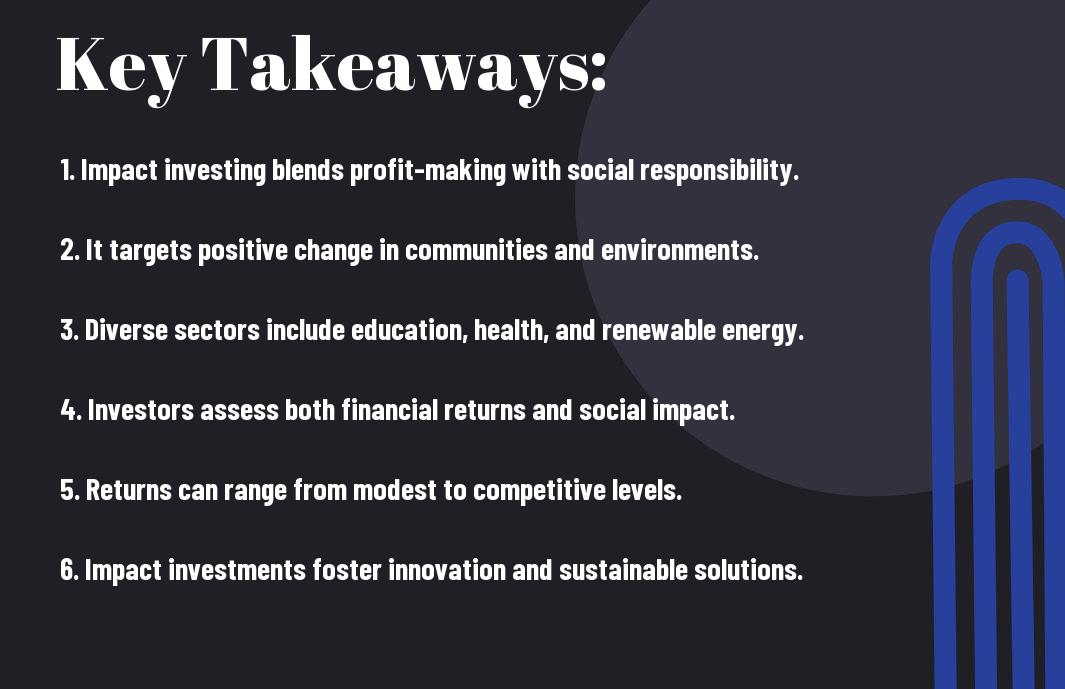Many people want to make a positive difference in the world while still earning money. Impact investing offers you a way to do both. This approach allows you to invest in projects and companies that not only aim for financial returns but also strive to create social or environmental benefits. In this blog post, you will learn about the principles of impact investing, its benefits, and how you can start making investments that align with your values.
Key Takeaways:
- Impact investing focuses on earning profits while also making a positive social or environmental impact. It’s about finding a balance between financial return and social good.
- Investors can support various areas, such as renewable energy, education, or healthcare. This allows them to align their financial goals with their personal values.
- By participating in impact investing, you contribute to meaningful change. Your funds help businesses or projects that aim to solve global challenges, making the world a better place.


What is Impact Investing?
A growing number of investors are exploring impact investing as a way to earn profits while also making a difference. This investment strategy focuses on generating positive social or environmental impacts alongside financial returns. For more insights on this topic, check out What you need to know about impact investing.
Definition and Key Concepts
Besides focusing on financial gains, impact investing aims to address social challenges, such as poverty and climate change. This type of investing involves directing funds towards projects that create measurable benefits for society and the environment.
Differences Between Impact Investing and Traditional Investing
Below, impact investing differs from traditional investing in a few key ways. Traditional investing prioritizes only financial returns, whereas impact investing seeks both profits and positive societal effects. This shift means that impact investors actively choose projects that align with their values and goals.
At its core, the main difference lies in the intention behind the investments. Traditional investors typically focus on maximizing profitability without considering the broader implications of their investments. In contrast, impact investors look for opportunities that not only yield financial rewards but also contribute to meaningful change in the world. This approach allows you to make a positive impact while still benefiting from potential financial gains.
The Importance of Impact Investing
Some people think that making money and helping the world are two separate paths. However, impact investing bridges this gap by allowing you to invest in projects that create positive social or environmental changes while also earning a financial return. This approach not only benefits you as an investor but also supports communities in need, leading to a better world for everyone.
Social and Environmental Benefits
After you choose impact investing, you contribute to projects that can solve real-world problems. These projects often focus on areas like clean energy, education, and healthcare. By supporting such initiatives, you help improve lives and create a healthier planet. Your investment can lead to better social outcomes, such as reduced poverty and education access, making a lasting impact.
Economic Advantages
By engaging in impact investing, you may discover solid economic benefits. Many impact investments have proven to yield competitive returns. This means that not only can you support meaningful causes, but you can also grow your investment portfolio in the process.
This trend has gained traction with recent data showing that impact investments often perform on par with or even exceed traditional investments. In fact, a report indicates that 88% of impact investors expect a financial return. When you invest with both purpose and profit in mind, you not only help drive positive change but also position yourself for financial growth. This dual focus can enhance your overall investment strategy.
Types of Impact Investments
Your journey into impact investing can take various forms. Here are some common types you might explore:
- Social Enterprises
- Green Bonds
- Sustainable Funds
- Community Investing
- Impact-First Investments
Any of these options can help you align your financial goals with your values.
| Type | Description |
|---|---|
| Social Enterprises | Businesses that focus on social goals. |
| Green Bonds | Bonds specifically for environmental projects. |
| Sustainable Funds | Investment funds focusing on sustainable practices. |
| Community Investing | Investments that support local communities. |
| Impact-First Investments | Prioritizing social impact over financial returns. |
Social Enterprises
Among the various impact investments, social enterprises stand out. These are businesses created to solve social problems while making a profit. They often address issues like poverty, education, and healthcare. By investing in social enterprises, you help create jobs and support local communities.
Green Bonds and Sustainable Funds
Around the world, green bonds and sustainable funds are gaining popularity. They focus on financing projects that have positive environmental impacts, such as renewable energy or conservation efforts. These investment types help you contribute to a healthier planet.
Hence, green bonds and sustainable funds not only allow you to earn returns but also make a positive difference. For instance, green bonds can help fund large-scale renewable energy projects. Sustainable funds often include companies committed to environmentally friendly practices. By choosing these investments, you are supporting a more sustainable future.

Measuring Impact
Unlike traditional investing, impact investing focuses on more than just profits. It aims to create positive social or environmental changes alongside financial returns. To understand this concept better, you can check out What is social impact investing?. Measuring this impact is important to ensure that your investments align with your values and goals.
Metrics and Frameworks
Before you can measure impact, you need to decide on the right metrics and frameworks to use. These tools help you evaluate the social or environmental effects of your investments. Common metrics may include job creation, carbon footprint reduction, or improved access to education. Using established frameworks can simplify your process and provide clear insights into the impact you are generating.
Challenges in Measuring Impact
The reality is that measuring impact is not always straightforward. It often involves qualitative data, which is harder to quantify than financial returns. Factors such as variability in results and the time needed to see significant changes can complicate your assessments.
To truly measure impact, you must face a few hurdles. Data availability can be a challenge. In some cases, organizations may not have enough data to provide reliable results. Additionally, the long-term nature of social change means that you might not see immediate results from your investments. Balancing quantitative and qualitative measures can also be tricky. It requires careful planning and evaluation to understand the overall effectiveness of your investments fully.

Popular Impact Investment Strategies
Now, let’s explore some popular impact investment strategies. These strategies help you generate profits while making a difference in society. They can focus on various areas like environmental sustainability, social justice, or community development. By understanding these strategies, you can make informed choices that align your financial goals with your values. Let’s dive deeper into two key strategies: thematic investments and community investments.
Thematic Investments
Thematic investments focus on specific themes that drive positive social or environmental change. For example, you might invest in renewable energy projects or companies that promote diversity and inclusion. This approach allows you to target industries that matter to you while potentially reaping financial rewards. By aligning your investments with your values, you can support causes you care about while still pursuing growth.
Community Investments
Among the popular impact strategies are community investments that focus on supporting local economies and enhancing social welfare. These investments often target underserved communities, aiming to provide affordable housing, healthcare, or education. Investing in businesses that serve these communities can lead to significant social change while also offering financial returns.
Indeed, community investments can play a vital role in fostering economic growth. By investing in local startups or social enterprises, you help create job opportunities and improve living conditions. They often generate supportive networks that boost local economies. You can also expect opportunities for engagement and collaboration with community members. This community-focused approach not only benefits those directly involved but also creates a ripple effect, enhancing the overall quality of life.
Risks and Considerations
Despite the benefits of impact investing, it’s important to consider the risks involved. These can affect your returns and the overall success of your investments. You can learn more about these factors in the resource Impact Investing: An Introduction. Being informed can help you make better decisions as you pursue both financial gains and social change.
Financial Risks
Behind the promise of profits lies the reality of potential losses. Impact investments can sometimes yield lower financial returns compared to traditional investments. This happens for various reasons, including market fluctuations and the nature of the business model. Always assess your risk tolerance before diving in.
Impact Risks
On the other hand, impact risks refer to the possibility that your investments may not achieve their intended social or environmental outcomes. A project may start strong but fail to create the expected positive change due to unforeseen challenges or insufficient funding. Therefore, it is vital to thoroughly research your investment opportunities to evaluate their genuine impact potential.
A well-known statistic is that around 30% of impact investments fail to meet their social goals. This highlights the importance of selecting trustworthy organizations and projects. By focusing on established and well-reviewed options, you can increase your chances of achieving both financial returns and meaningful social change.
To wrap up
From above, you can see that impact investing allows you to earn a profit while also making a positive change in the world. This approach helps you support businesses and projects that tackle social or environmental issues. By choosing where to invest wisely, you can align your financial goals with your values. So, consider exploring impact investing as a way to make a difference and grow your wealth at the same time.
Impact Investing Explained – Generating Profits While Creating Social Change
Impact investing is an important topic today. It combines financial returns with social benefits. Let’s break it down, using the E-E-A-T framework, so you can understand this concept clearly and apply it to your future decisions.
What is Impact Investing?
Impact investing is when individuals or organizations choose to invest money into businesses or projects that aim to solve social or environmental problems. This way, investors can earn profits while making a positive difference in the world.
Why is Impact Investing Important?
This type of investing matters because:
- It helps address issues like poverty, climate change, and education.
- It encourages sustainable business practices.
- It can lead to significant financial returns for investors.
How Does Impact Investing Work?
Investors identify sectors or organizations that align with their values. Common areas include:
- Renewable energy
- Affordable housing
- Healthcare
After deciding where to invest, the money is used to support projects or businesses that create positive social change while also aiming for financial growth.
Benefits of Impact Investing
There are many benefits to impact investing:
- Financial Growth: Investors can earn good returns.
- Social Good: Investments lead to positive changes in communities.
- Informed Choices: Investors can focus on what matters to them.
Key Takeaways
Impact investing is about finding the balance between making money and helping others. By choosing the right investments, you can contribute to social change while building your financial future.
Frequently Asked Questions (FAQ)
Q: What is the main goal of impact investing?
A: The main goal of impact investing is to generate positive social and environmental impacts alongside financial returns. Investors want to see improvement in areas like health, education, and the environment while also making a profit.
Q: How do I get started with impact investing?
A: To start, research impact investment funds or platforms. Look for those that align with your values. You can also consult with financial advisors who specialize in impact investing to help guide your choices.
Q: Can I invest in impact projects through traditional stocks?
A: Yes, some traditional companies focus on sustainability and social issues. Investing in these companies can be a form of impact investing. Look for firms known for their social responsibility and positive community contributions.
Q: What are some examples of impact investments?
A: Common examples include investments in renewable energy companies, affordable housing projects, and social enterprises that provide training and job opportunities for disadvantaged communities. Each of these aims to address specific social issues while generating profit.
Q: Is impact investing risky?
A: Like any investment, impact investing carries risks. It’s crucial to conduct thorough research before investing. Some impact projects might take longer to show returns. Therefore, balance your investments with traditional options to manage risk effectively.
Conclusion
Impact investing is not just a trend; it is a way for individuals to participate in creating a better world while growing their finances. Consider it as an opportunity to invest where your heart lies.
By understanding impact investing, you can combine your financial goals with your desire to create positive change. Start exploring your options today!




